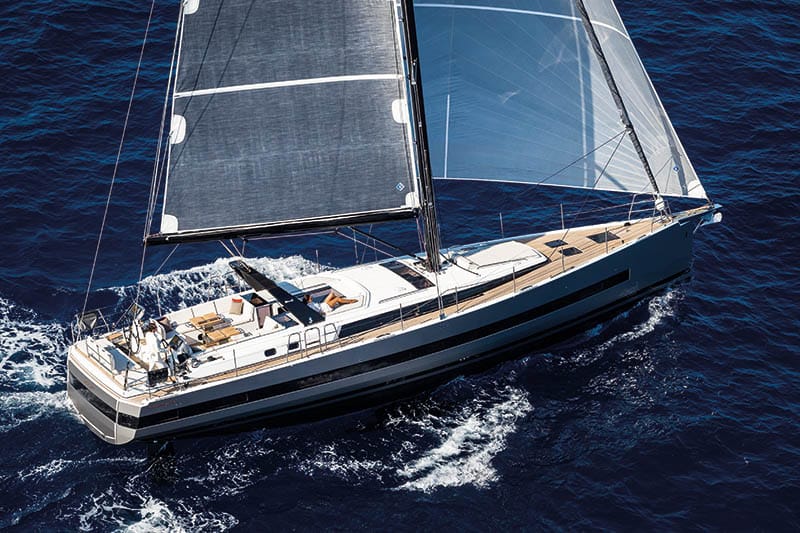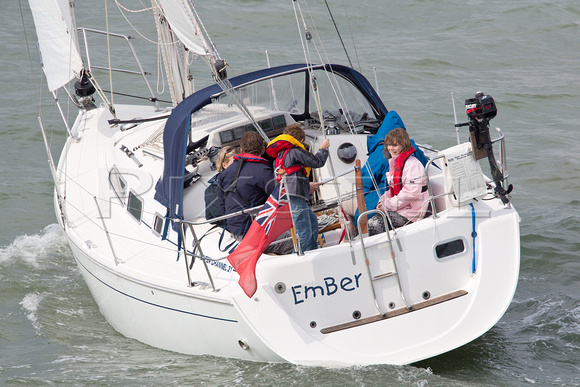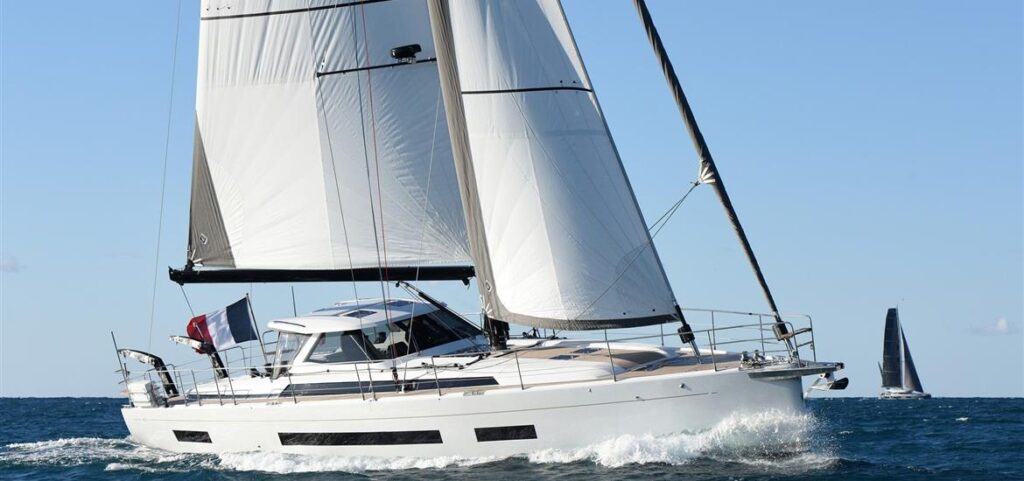Best Sailboats to Singlehand
Sailing alone can be an extraordinary experience for many boaters. Many have attempted to sail on long passages and explore the oceans. But, a common concern is, which one is the right boat to sail single-handed? We’ll find out together in this article. Fortunately, there are many suitable seaworthy vessels for one person. In this article, I list you the best boats to single-hand as well as find out what makes them appropriate for single-handing. These boats range from small lake dinghies all the way to comfortable cruisers capable of oceanic crossings. So, keep reading!
A Few Things About Single-Handed Sailing
There are many boats that perform particularly well for shorthanded sailing. However, the fact is that the structures on a boat have a greater effect on its suitability rather than the boat’s construction. Main features regarding single-handed sailing include easy sail controls, including the ability for one person to quickly tuck a reef in. And, let’s not forget the ability to easily change the sheets and the mainsheet traveller. If you’re looking for a boat to short-handed sail, start by looking at the reefing and sail handling systems, as well as the pilot’s specifications. It’s a great advantage to be able to reach both mainsheet and the primary winches from the helm. But, when sailing on long passages then the pilot might be steering for almost 100% of the time.
For shorthanded sailing, many sailors prefer smaller vessels. This point has a lot of sense because their compact size, ease in navigation in a small room, and less complicated structures, make them more simple to sail. But, keep in mind that there are also sailboats of 70ft that are set up to be handled by 1 or 2 persons on deck. In which case, the sailors must be experienced and be able to fix any damaged system. So, if a vessel is properly set up it can be easily handled by one or two experienced sailors, no matter its size.
Boats made from the early 1990s onwards are more stable than their ancestors, as well as deep draught low center of gravity keels. These are a great choice for single-handing. The added stability means a reduced need to reef which facilitates the overall sailing experience and performance.
In any case, the below-mentioned boats, and similar others in each respective range, form great choices for single-handed sailing. They all offer easy short-handling for either beginners or experienced. And also for those that want to experience calm sailing to those seeking a fast and responsive, but ultimately safe, vessel.
Handling and Set-up
First of all, when solo sailing, it’s important to focus on the ease of handling your boat. This is because you will be in charge of all roles; skipper, navigator, bow-person, dial trimmer, engineer, and chef! So, what you want to achieve here is making all these roles simpler in order to facilitate all tasks.
So, it’s advisable to take your boat out on a calm sea and experience all possible motions of sailing. Like you were racing or cruising but also hoisting sails, trimming, steering, and navigating. Like this, you will be able to see if any problems come up. The most common problem sailors experience is reefing the mainsail by themselves. Also, the spinnaker pole might be too much to handle by yourself or find it difficult to reach the sheeting positions.
In other words, if you’ve never sailed short-handed before, this first experience might seem challenging. And, some things are really important to handle like reaching the main traveler while steering. But, don’t get discouraged! Consider taking notes while onboard, and start finding new ways of facilitating your voyage.
Some simple changes include shifting a halyard clutch. But, there are more challenging ones like switching to a single-line reefing system. Wherever feasible, a single-line reef system is preferable. But, adding a reef tack line and getting back to the cockpit can be even more convenient and require less line that will probably tangle in the cockpit. Keep in mind that the most important factor for single-handed sailing is to make your boat easier to sail. So, now let’s see the best boats for single-handed sailing!
HANSE 371
The Hanse 371 was built from 1999 until the mid-2000s. The boat offered a selection of either deep or shallow low center of gravity fin keels. These were joined with the hull and a long waterline. Below the deck, you can choose between 2 or 3 cabin layouts with a comfortable galley. Hanse 371 benefits from self-tacking jibs so when tacking all you have to do is spin the wheel. And, in case you’re sailing on autopilot you just press a few buttons and you’re good to go.
In addition, you can increase sail area when reaching in light air with a Code 0 or asymmetric spinnaker. This model maximizes the amount of space and with a reasonable budget. So, with its great interior and performance, the Hanse 371 is a seaworthy vessel that may cost you around $60,000. Most importantly keep in mind that everything is standard and easy to use. Like this, you simplify your life while sailing single-handed.
Jeanneau Sun Fast 3200
The Jeanneau Sunfast 3200 was manufactured with offshore short-handed sailing taken into account since the beginning. This boat is not only a classical sailing boat but also a small and light one that is easy to navigate. Even better, it has the durability and strength to withstand long passages. And, for this reason, they built it specifically for the Trans-Atlantic race. This boat is especially impressive when you sail off the wind, and totally practical and reliable even when sailing alone. This could be due to the fact that the design and setup are mostly constructed for racing. So, it could be ideal for you if you’re looking for a coastal cruiser that’s easy to handle.
Even when sailing downwind, you can easily achieve double figures in terms of speed with this boat. In particular, the Sunfast 3200 features cutting-edge technology to provide you with the best strength-to-weight ratios possible. It has all of the requisite features to easily adapt it to perform admirably as a sailing or racing sailboat. The boat features two double cabins, a chart table, a galley, and a head compartment.

>>Also Read: Best Sailboats Under 20ft
Beneteau Oceanis 62
Let’s now pass to the bigger fellas! As aforementioned, single-handed sailing doesn’t mean you have to choose small sailboats. This is because nowadays single-handed 60+ ft boats aren’t that rare in terms of production, as they were in the past.
Basically, the Beneteau Oceanis 62 meets the modern demands of today’s market and was specifically designed to provide ease of use. In other words, it can be easily handled and operated by a single person. I know that all this space might be a bit exaggerated, but if you’re the kind of person that enjoys being in oceanic solitude while benefiting from having a moving apartment, then this one is for you! Of course, there are more boats of the same size suited for short-handed sailing, like the Hanses, Bavarias, and Jeanneaus. But, you can find a new Oceanis 62 for around $724,500, which is a great price for boats of that size combining both performance and quality.

>>Also Read: Is It Dangerous to Sail Around the World?
Hunter Channel 31
From the mid-1980s onwards, this British boatbuilder transitioned from racing to powerful but easy-to-handle small cruisers. As a result, a series of boats has been developed that can sail almost effortlessly without losing handling characteristics.
The deck layout features an effective layout, with an optional self-tacking jib and single-line mainsail. As a short-handed sailor, you’ll benefit from the tiller steering, which allows you to steer with your legs while trimming sails. The accommodation below decks is well-designed and provides considerably more room than the previous Horizon 30 model.
This model, which debuted in 2001, was of higher quality than the majority of Hunter’s other cruising models and greatly focuses on performance. It was also one of the company’s last all-new designs, so it benefited from the most up-to-date design at the time. This was especially apparent in the well-balanced hull shape, which also provided excellent form stability. Joined with high ballast ratios and low center of gravity keels resulted in a boat that doesn’t need continuous trimming to maintain high average speeds or avoid repeated broaching in gusts.

>>Also Read: How Far Can you Sail in One Day?
J/109
This is the prototypical short-handed performance boat in several respects. Long-distance single-handed and double-handed sailors love it as well as inshore racing teams. The boat’s offshore reputation has been well established, with many North Atlantic crossings under its belt. Although J/109 is often considered as a planing boat, this 19-year old model is too heavy to be one of that kind. It is basically a moderate all-rounder that offers great performance with the ability for extended surfing when offshore. The boat is also available in a shoal draught form, but it didn’t sell that much.
A great advantage is that the big asymmetric spinnakers can be easily gybed from the cockpit in light airs. And, a poled-out jib can still provide fast downwind speeds with an enviable degree of control in a true wind of more than 20 knots. Almost everyone sailing J/109s short-handed, at least in Europe, hasn’t used the boat’s original overlapping genoas so as to employ blade jibs that are set on roller furling gear.
The only downside is that the boat is expensive for one of this size on the second-hand market. However, its quality of construction and the high standard equipment aren’t going to let you down. Moreover, the interior layout is sparse and has less interior space, although it provides a well-designed and effective two-cabin compartment.
Catalina 315
This is a stylish pocket cruiser that raises the bar for solo sailors by providing exceptional comfort and efficiency. With a hull length of 31′, the Catalina 315 has more interior space than most classics and is still ideal for solo sailing. Rigging the Catalina 315 is a lot simpler with a masthead sloop because it has both an in-mast roller furling mainsail and a roller furling genoa.
Despite the fact that it is a much larger boat, it has a few key features that make all the difference. The split backstays, for example, are excellent for balance and functionality. This is one of the key reasons it was named the 2013 Boat of the Year Best Inshore Cruiser by Cruising World. The boat might surpass your needs when sailing solo, as it is a high-end sailboat with a price tag of more than $175,000. However, if that seems too pricey, you can look for a used model, which will be slightly less expensive.

Pacific Seacraft Flicka 20
The Flicka is a 20-foot sailboat developed and planned for extended cruising and bluewater sailing. The Newport workboats of the 19th century were distinguished by their sweeping sheer, proud bowsprit, blunt bow, broad beam, and low side decks. Flickas by Nor’Star and Pacific Seacraft have withstood the test of time. This is because most Flickas were made with polyester resin or vinlyester resins later on in the production.
For some sailors, this is a disadvantage as you don’t realize just how small the Flicka is until you step into the cockpit. However, it’s a seaworthy vessel and offers a remarkably spacious interior. In addition, the robust tiller is mounted on the transom, thus giving good leverage for steering and freeing up cockpit space. As for the interior, there really is enough standing headroom as well as the open-plan without a full forward bulkhead opens things up. The galley offers all basic equipment and the V-berth is large and comfortable.
On top of that, the Flicka is towable, seaworthy, and you can actually liveaboard. Even though it is a small craft you can still cross the oceans with it. On this one, there’s no denying that everything is within easy reach. At this scale, ergonomics are almost irrelevant. Because of its towability, the fact that it can be parked in your garden, and its short-handed capability, it’s the ideal spontaneous getaway vessel.
Amel 60
Amel 60 definitely got your back while sailing solo in the oceans. The Amel 60 features great advantages and, with its rectangular hull portlights and wraparound windscreen, it takes you on the modern cruising generation.
Fixed bowsprits and plumb bows ensure a modern design and experience. In addition, lines open out into beamy sections aft and benefit from twin rudders. And, since these forms, when paired with the proper buoyancy distribution, can provide a faster hull form, it’s a no-brainer for cruising designs to follow the secondary benefits that come with this fuller form. The watertight bulkheads ensure that the boat won’t sink. Moreover, the cockpit has a sturdy roof and windows, so you’ll be safe no matter the weather. And, the stable hull ensures great handling even in challenging weather conditions.
One of the main benefits is the increased volume, which applies to both the accommodation and the deck lockers. When heeled, twin rudders minimize drag and provide a more balanced feel while underway. However, if they get damaged they provide a redundancy level. The shallower rudders also help in mooring stern-to for those who spend more time in areas like the Mediterranean. In the interior, you get enough space and luxury as well. There’s even a washing machine! So, even if you are an experienced single-handed sailor that wants to benefit from space and performance, then with the $1.5 million price you will get this luxurious boat!

Beneteau 31
As a small cruiser keelboat, this French-designed vessel is predominantly constructed of fiberglass and is ideal for single-handed sailing without minimizing interior space and comfort. Its galley has ample storage and counter space, as well as a sit-down navigation station with a small table. The interior benefits from the straight-lined and elegant thinking of Nauta Design. The comfy seats on either side of a drop-leaf table double the living space. There’s also a spacious athwartship aft-cabin berth and V-berth.
Under power, maneuvering this boat is a breeze, and it’s well worth it for any solo sailor looking for a coastal cruiser. It has a fractional sloop rig, which allows for in-mast furling. This makes it simple to control while also making it strong in light winds. A bow pulpit and an optional asymmetric cruising chute will enhance the performance if you’re sailing the boat off the wind. The new 31 is estimated to cost about $115,000, which is very pricey but well worth it if you want to cruise the globe in this French masterpiece.
Best Sailboats for Solo Sailing – The Bottom Line
Singlehanded sailing is a great achievement in terms of adventure and endurance, especially for lone sailors that cross the oceans. Many experience sleep deprivation, the stress of being alone, and difficult weather conditions that have to be handled by yourself. So, if you decide to set sail for an offshore voyage on your own is a big step to make. And, surely you need a sturdy and seaworthy boat. All the aforementioned boats are considered to be the best cruisers for single-handed sailing. It is up to you to decide which one to choose. This will be determined according to your budget, preferences, needs, and course of your voyage. And, remember that sailing solo learns you to live independently which is a great achievement!
